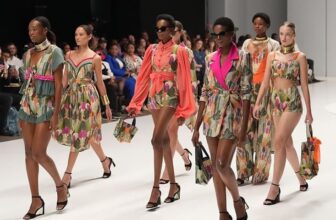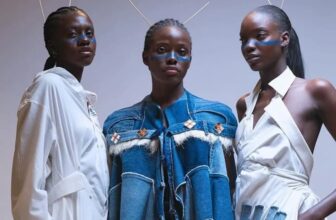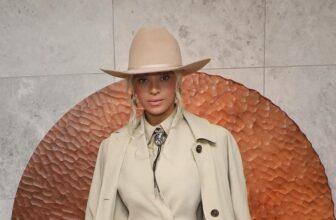The cape dress, with its elegant and regal silhouette, has become a favorite among A-listers on the red carpet and even members of royal families.
Throughout history, capes have been a practical garment for covering up, and now fashion designers are emphasizing their importance in any collection. It’s no surprise that capes have become a notable trend embraced by royals and celebrities alike.
The popularity of capes among these high-profile figures can be credited to various factors, such as their historical significance, influence from pop culture and fiction, the endorsement by fashion designers, and the strong impact of celebrities and royal family members on shaping modern fashion trends.
The cape fashion trend has a rich and ancient history, making a comeback in today’s fashion scene due to a blend of cultural, historical, and design factors.
What is Cape Fashion?
Capes are a type of outer garment that is sleeveless and open at the front, typically designed to drape over the shoulders and hang loosely around the back, often reaching to the mid-calf or longer. They are typically worn over other clothing. Mostly associated with the regal charm of royalty and influence, capes come in a diverse range of lengths and styles, catering to various fashion preferences and occasions.
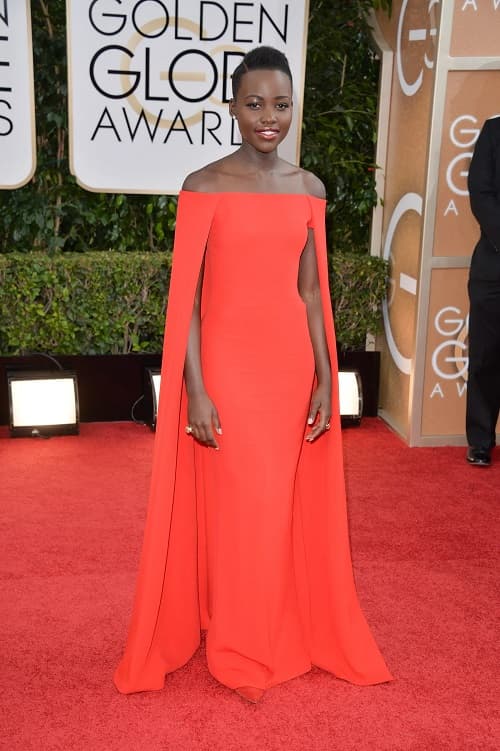 Photo: George Pimentel
Photo: George Pimentel Lupita Nyong’o wearing Ralph Lauren cape dress at the Golden Globes in 2014, the year she was nominated for 12 Years a Slave.
Classic capes typically extend to the mid-calf or just below the knees, offering ample coverage and an elegant silhouette. Shorter styles, known as capelets, fall at the waist or hip level, providing a more casual and modern look. Some capes have hoods, adding a touch of practicality and a mysterious aura, while others feature collars or decorative trims for added flair.
Capes may also be designed with asymmetrical hems, giving them a contemporary twist. Whether tailored and structured or flowing and ethereal, cape dresses remain a fashion sensation that can elevate any outfit with their unique charm.
History of Cape Fashion
The history of capes has always been linked to prestige, power, and authority. In Roman times, military commanders often wore capes fastened at one shoulder, as depicted in their statues. In medieval Europe, capes were commonly worn by both the rich and the poor, typically with hoods attached. The earliest record of cape dresses dates back to a 1066 illustration of a soldier or shepherd with a draped cape across his shoulder.
At that time, leaders and high-ranking individuals donned capes to symbolize their status and leadership. This association with royalty and nobility persisted through the Middle Ages and the Renaissance. During the Victorian period in the 19th century, the combination of capes with chaperons or hoods became fashionable in Europe.
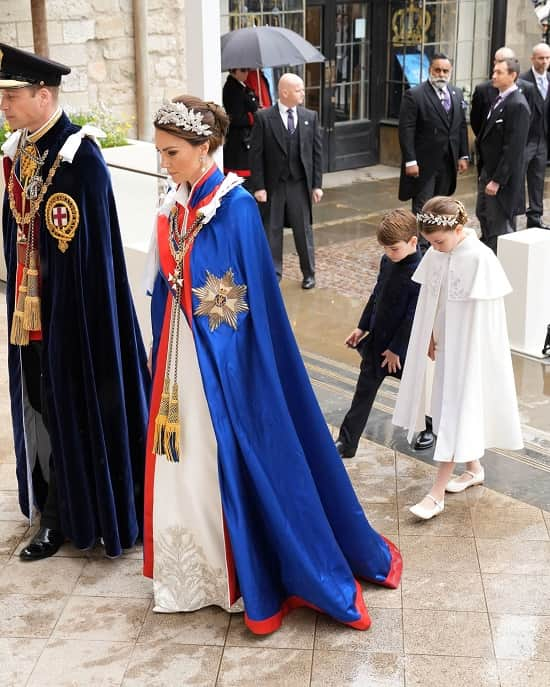 Photo: Dan Charity/Pool via REUTERS
Photo: Dan Charity/Pool via REUTERS Prince and Princess of Wales, Prince William and Kate Middleton, Prince Louis, and Princess Charlotte arrive for the coronation ceremony of Britain’s King Charles and Queen Camilla at Westminster Abbey, in London, Britain May 6, 2023.
Capes also held religious significance, as Muslims, Jews, and Christians in Arabia and the Levant region wore a cloak similar to today’s abaya. The history of the abaya, like the cloak fashion, remains somewhat uncertain, but historical evidence indicates its use in ancient Mesopotamia as well.
Capes have also been popularized in pop culture and fiction, especially in superhero stories. Iconic superheroes like Superman, Batman, and Thor wear capes as part of their distinctive costumes, leading to a fascination with capes as symbols of strength, elegance, and mystery.
The Evolution of Cape Fashion
In more recent times, capes have transcended fiction and made their way onto the red carpet, adorning celebrities at prestigious awards shows and events. Asides from the fashion designers that have recognized the allure of capes and incorporated them into their collections, royals from different parts of the world have also embraced the charm of evening dresses with cape detailing.
Figures like Kate Middleton, the Princess of Wales, Meghan Markle, and Queen Maxima of the Netherlands have all been seen wearing these elegant cape dresses. The combination of simplicity and sophistication in these outfits makes them a timeless classic, often enhanced with the dazzle of exquisite jewels.
 Photo via Hellomagazine.com
Photo via Hellomagazine.com Meghan Markle looked beautiful and dignified in a Stella McCartney cape dress during Queen Elizabeth’s State Funeral.
One unforgettable moment was when the Princess of Wales captivated the world at the James Bond premiere for ‘No Time to Die,’ stunning everyone in a splendid Jenny Packham ‘goldfinger’ dress with a captivating cape. Similarly, the Princess sparkled in a dramatic floor-length sheer cape covered in gold metallic sequins. Her fashion choice created a frenzy, with the dress quickly selling out in most sizes, proving the enduring appeal of the cape fashion trend.
Cape dresses come in a variety of fabrics, each offering unique textures and draping qualities suitable for different occasions and weather. Luxurious materials like silk or satin are preferred for formal events, while wool and cashmere capes are great for colder days and casual outings. Adding to their charm, capes can be adorned with embellishments like embroidery, sequins, beads, or lace, adding a touch of sophistication.
Some capes have fastenings like buttons, clasps, or ties, while others simply drape freely over the shoulders. Capes are incredibly versatile and can instantly elevate any outfit, whether it’s a dress, gown, jumpsuit, or even more casual attire. This versatility makes them a go-to choice for celebrities who want to make a statement on the red carpet or in public appearances.
Influence of Capes on Contemporary Fashion
The cape fashion trend has experienced periodic comebacks throughout history and is now enjoying another moment of popularity. As mentioned earlier, celebrities and royalty play a significant role in popularizing the cape trend. Their appearances in capes at high-profile events and shows often lead to increased demand for similar styles in the fashion market.
Fashion designers have been incorporating capes into their collections, presenting various designs and interpretations of this cloak wear. During the FW20 runways in New York and Paris, capes stood out as a prominent trend. Notable designers like Rick Owens and Givenchy’s Clare Waight Keller embraced this trend, offering unique capes in different styles.
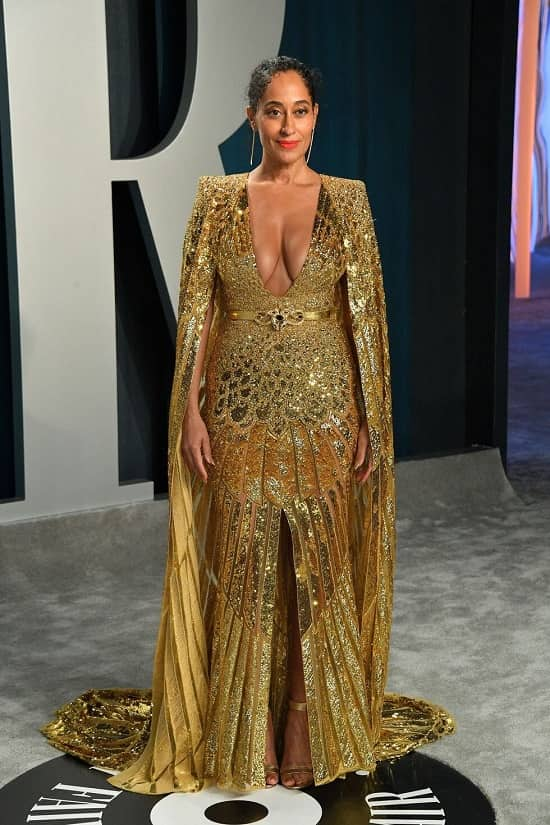 Photo via The Bridal Finery
Photo via The Bridal Finery Tracee Ellis Ross wearing Zuhair Murad cape dress at the Oscars 2020.
Rick Owens showcased a long statement puffer cape in baby blue, while Clare Waight Keller presented seductive red pagoda shoulder cape slim-fit dresses, inspired by French cinema stars. Dior’s FW20 collection featured a sculptural black ruffled cape, further affirming the popularity of capes in the fashion world at that time.
Capes have seamlessly found their place in diverse fashion styles, spanning from royal elegance to bohemian charm and modern minimalism. Their regal allure and timeless aesthetics have made capes an iconic trend that captivates those seeking a touch of sophistication and grace in their attire.
Whether adorning a full-length cape for a special occasion or opting for a chic cape coat for everyday wear, people; royals, and celebs alike continue to embrace capes as a choice that has come to stay in the ever-evolving world of fashion.



